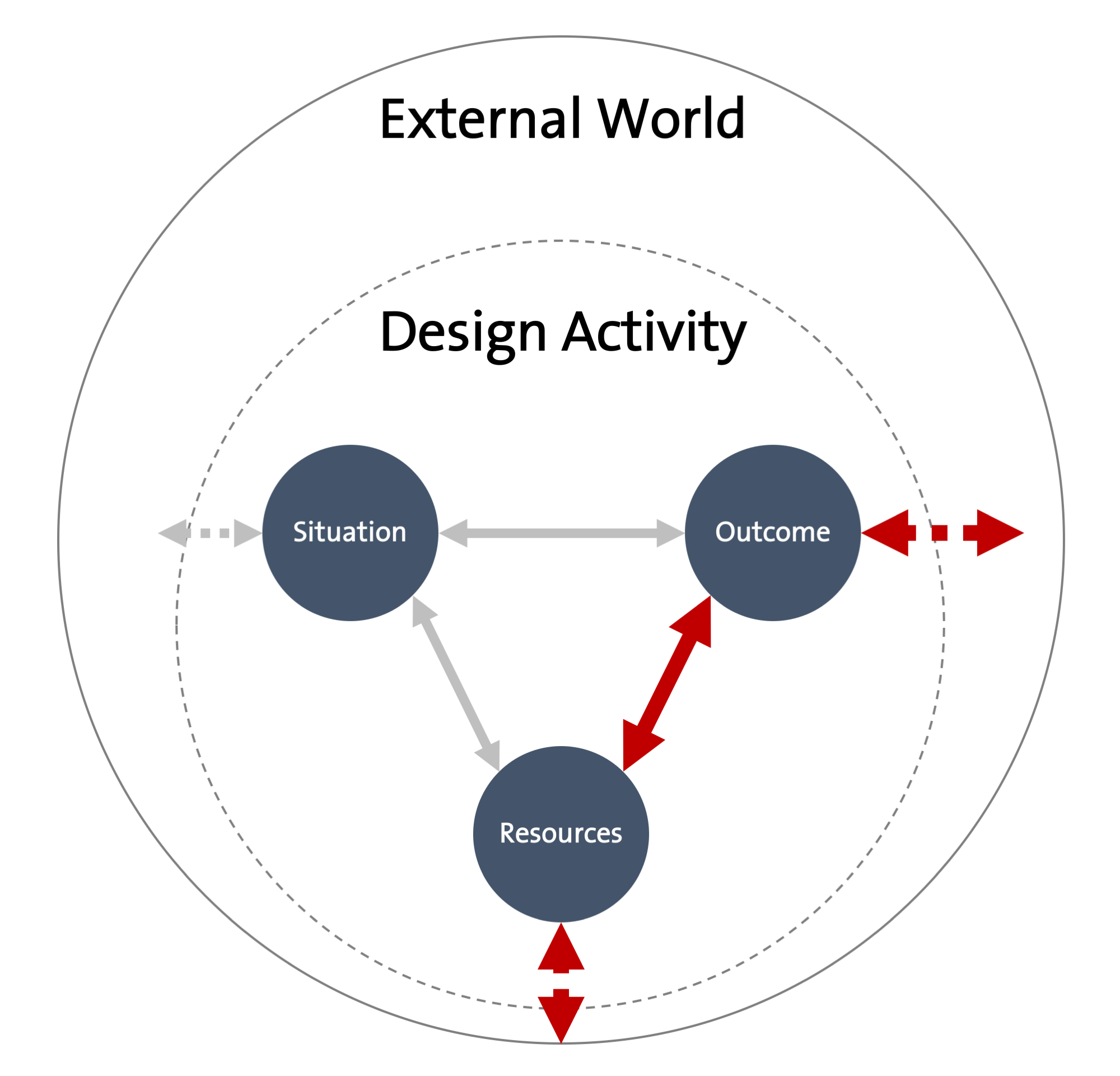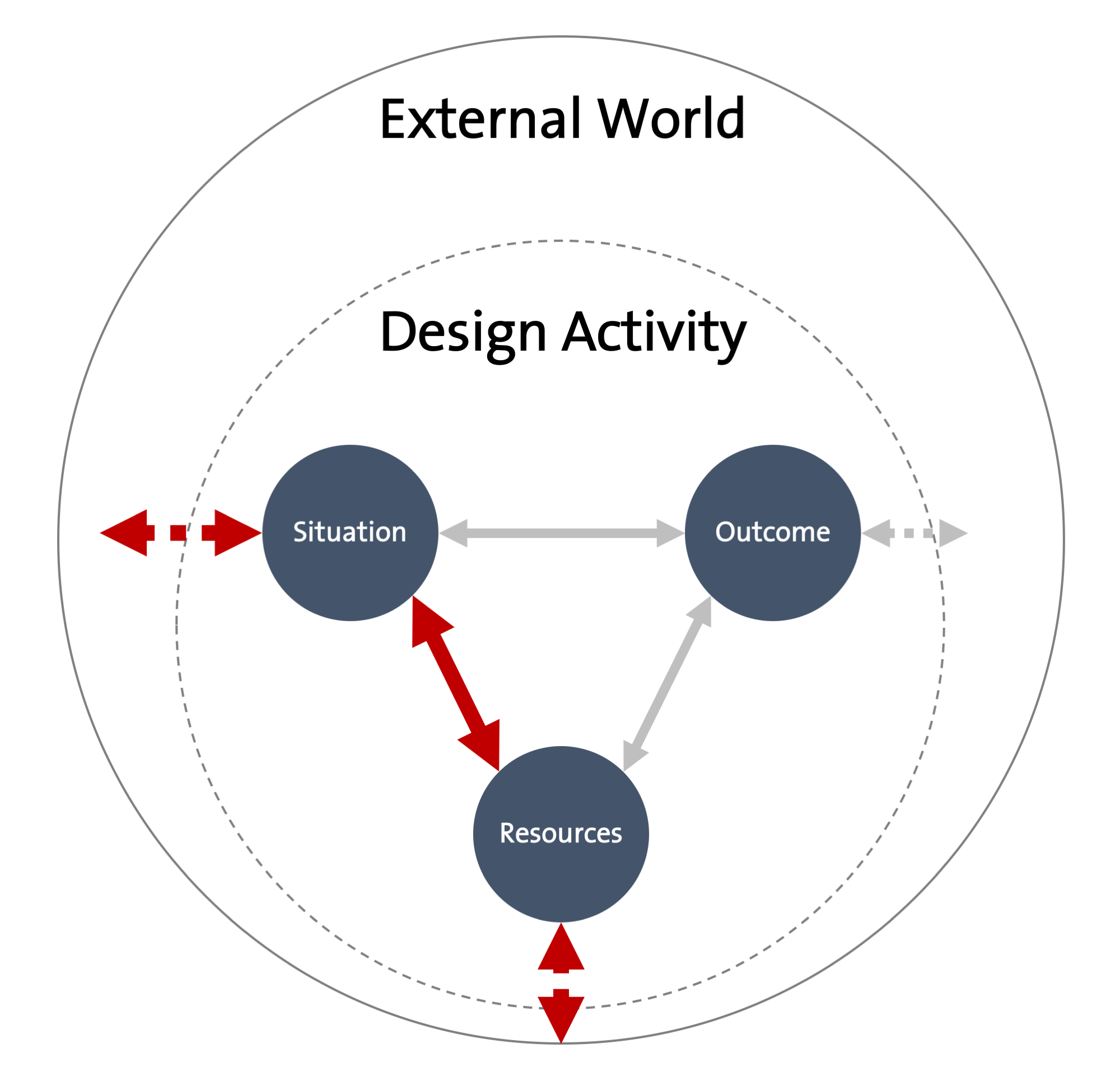Pattern Language
“The real power of patterns is not to hand us exotic solutions, but to give us a way to remember the simple, ordinary, basic solutions that we know but forget”. Rising 2010

Design activities are characterized by inherent instability - complex and dynamic relations among design situations, design outcomes and design resources. We believe that these active ties are primary sources of complexity characteristic for design activities. As mentioned in the introduction, while design situations, outcomes, and resources are themselves complex structures, what makes a design activity additionally and characteristically complex are relations among these structures. Dynamics of these relations challenge designers’ ability to deal with complexity as any of the structures are subject to change, in a difficult to predict ways.
We want to achieve two goals. Firstly, we want to show that, in design, it makes no sense to treat design situations, design outcomes and design resources as stable elements and in isolation of each other. Furthermore, we want to challenge the conventional idea that the design process moves from a problem to a solution linearly and causally. Instead, the dynamics of the network connecting design situations, design outcomes, and design resources are highly diverse. Of course, there already exists a significant diversity in how design literature describes these dynamics. However, we still find it necessary to contribute to this ongoing debate by providing another perspective and hopefully useful, more structured model.
Secondly, we want to show that regardless of the seeming arbitrariness of interactions between design situations, outcomes, and resources, it is still possible to constructively portray, investigate and discuss such dynamics. In other words, we want to argue that in many cases these dynamics show signs of “organized complexity,” where we may observe some patterns. As a mean to achieve this goal, we introduce a concept of patterns of dynamics between elements of design activities. A pattern is a recurring arrangement of interactions among elements of design activities. By studying contemporary design literature, we have found several common patterns of these dynamics. It is important to note that these patterns are primarily conceptual tools. The purpose of patterns is to support analytic and reflective thinking for practical purposes and not to serve as strict scientific definitions of existing elements.
The patterns of dynamics illustrate how people deal with ambiguity, uncertainty, and complexity when they attempt to change the world. As such, these patterns are universal to all design disciplines. Design disciplines may differ in which situations they address, which outcomes they create and which resources they use. But the way how people deal with ambiguity, uncertainty, and complexity is cross-disciplinary. Consequently, we have found examples of all patterns of dynamics in all of the design disciplines we analyzed.
With eleven patterns, we provide an initial categorization and description of dynamics that we have identified between design situations, outcomes, and resources. We are aware that it is not possible to capture all patterns that may occur in design processes. By examining findings from contemporary seminal design research, we abstracted some core patterns into a format that can support discussions about design complexity.
None of the described patterns is universally good or bad. Each pattern may be desirable in one situation, and undesirable in another. Patterns may be a consequence of a conscious effort to create particular design dynamics, or they may occur accidentally.
For convenience and clarity, we describe each pattern of dynamics with the same format:
- a brief descriptive name,
- a “motto,”
- optional alternative names,
- a definition,
- a short list of topics related to the pattern,
- a brief description of when the pattern is desirable and undesirable, and
- a more detailed discussion based on examples from the design literature.
We structured our review of patterns, based on our model, around three “axis” of relations between “elements” of design activities:
- dynamics between design situations and outcomes,
- dynamics between design outcomes and resources,
- dynamics between design situations and resources.
Each pattern may be viewed as the description of dynamics that shape design decisions during design activities. In any design activity, designers make many choices, trying to answer the following questions (Obrenovic 2008):
- How will the design process advance?
- What needs and opportunities will the design address?
- What form will the resulting outcome take?
Our patterns describe dynamics that influence decisions that designers make when trying to answer these questions. When we look at the result of some design activity, with hindsight, we usually can describe what the design outcome is, how it has changed the original design situation, and what design resources have been used. However, a route to the design result may be very complicated, and with very diverse starting points. As we will illustrate with our patterns, sometimes, we may start with a problematic situation that we want to improve. Sometimes we may not have a problem to solve but a technology that people suddenly start to use. And sometimes the sheer availability of some design resource may be the primary driver of change. And frequently, multiple of these patterns of dynamics will co-occur.
A. Patterns of Dynamics Between Design Situations and Design Outcomes

The dynamics between of a design situation and a design outcome seem to be the most extensive in any design activity. In the design literature, we have found several common and often interconnected views on dynamics of this relation, which we describe in the following five patterns:
- Co-Evolution of Problem-Solution,
- Puzzle Solving,
- A Solution Looking for a Problem,
- Pandora’s Box, and
- The Force Awakens.
B. Patterns of Dynamics Between Design Outcomes and Resources

Similar to the dynamics between design situations and outcomes, the dynamics between design outcomes and design resources are in design literature described as sophisticated and bidirectional. The way how designers set the design process when it comes to steps, phases, and activities has direct consequences on what they can design. On the other hand, design outcome may also influence design resources. We discuss the following patterns of dynamics:
C. Patterns of Dynamics Between Design Situations and Design Resources

Design situations and design resources relate to each other in many ways. A designer is often pictured as a craftsman, someone who picks and chooses tools freely based on the case and grounded in the judgment of overall benefits from using a specific resource (Stolterman 2008). Some resource selection criteria are influenced by the specifics of the design situation at hand, and the designer has limited influence on them. Budget limitations, for instance, can affect the selection of materials and consequently tools and processes to work with these materials. The deadline imposed by clients may restrict the number of design iterations and limit the amount of testing and evaluation. Size and criticality of a situation may ask for different software development approaches (e.g. Cockburn 2000).
The choice of design resources is never trivial and never a sole function of the situation requirements. The ‘benefits’ of using some tools also depend on the level of skill and mastery required, external pressure about standards, personal style of expression. The designer is also almost never in full control about which resources will be used and how they will be adapted to a particular situation.
We discuss the following patterns of these dynamics between design resources and situations:
- Conformity,
- Commitment, and
- Cherry Picking.
D. Emergence of Complex Patterns of Dynamics
“Every place is given its character by certain patterns of events that keep on happening there.” (Christopher Alexander, The Timeless Way of Building)
The patterns of dynamics of design activities may facilitate describing complex dynamics between elements of design activities as a combination of several higher-level arrangements of such dynamics. With patterns, we can explain, compare, and contrast, diverse and complex design activities in similar terms and on a higher level of abstraction.
We can, for instance, talk about some typical combination of patterns. When a new situation appears, designers’ attempt to change that situation may lead to the co-evolution of problem-solution pattern. Designers may need new or better resources for this situation, which will lead designers to change their ways of working and to the emergence of the inverse Conwayian laws pattern. Through commitment and eating its own dog food patterns the new resources can further develop and gain popularity. Once stable and popular the resources may become a de facto standard, and lead to the conformity pattern. The conformity pattern may lead to the Conwayian laws pattern. The Conwayian laws pattern, on the other hand, may trigger a reaction of customers wanting something new and original, which may result in new design situations.
The patterns of dynamics may be useful to discuss different levels of difficulties of design. Or, to paraphrase the Christopher Alexander’s quote, we can argue that every design activity is given its character by patterns of dynamics that keep on happening there. Similar to Gero (1990), we may talk about routine design vs. innovative design, later generally considered more difficult. In routine designs, designers normally have better-defined situations, and they are using familiar and proven tools. There we may primarily expect to see the commitment pattern and possibly the puzzle solving pattern, with little of other patterns occurring. A routine design may also be the consequence of the cherry picking pattern. In innovative designs, on the other hand we may expect to see the co-evolution of problem-solution pattern, with possibly the design-by-buzzword and solution looking for a problem patterns. The innovative or creative design is also more likely to lead to the force awakens and pandora’s box patterns, as we are dealing with more novel and unknown elements.
The patterns of dynamics strongly suggest that designers need techniques to estimate both the short-term and long-term impacts of design. In this aspect, we support the view of Penzenstadler et al. (2014), who argued that software designers could considerably improve civilization’s sustainability by taking into account not just the first-order impacts of software systems but also their second- and third-order impacts. We believe that our framework could support such reasoning. The patterns illustrate that design activities have both a short-term and long-term dynamics. The short-term dynamics are typically localized within a particular project and are occurring in a limited period. The long-term dynamics are happening over a more extended period and among multiple projects. For example, the co-evolution of problem-solution pattern usually is intrinsic to the design activity and people involved in it, and the pattern is occurring during a concrete project. The force awakens pattern, on the other hand, is primarily a consequence of indirect interactions through many elements outside the main design activity. Some patterns reflect both short-term and long-term dynamics. For example, the eating its own dog food pattern has an immediate short-term effect on the project where it is being used. But because it promotes and stimulates the development of specific design resources, on the long-term it may influence other design projects.
Questions to Ask Yourself
- Which patterns of dynamics typically occur in your design activities?
- Are there some patterns that occur more often than the others?
- Are there some patterns that do not occur at all?
- How do you estimate the potential impact of your design outcomes, both short and long term?
Cover Art
The formation of complex symmetrical and fractal patterns in snowflakes exemplifies emergence in a physical system. In philosophy, systems theory, science, and art, emergence is whereby larger entities arise through interactions among smaller or simpler entities such that the larger entities exhibit properties, the smaller/simpler entities do not display. Credit: Wikimedia Commons.